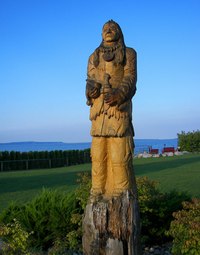
Source: Link
WAWATAM, Ojibwa chief at Michilimackinac; fl. 1762–64.
Wawatam is known to history as the man who rescued the trader Alexander Henry* during the Ojibwa uprising at Michilimackinac in 1763. According to Henry’s Travels and adventures, in the spring of 1762 Wawatam, inspired by dream, adopted him as a brother. A year later the Ojibwa, whom Henry described as about 45 years old and “of an excellent character among his nation,” came to him visibly disturbed and begged him to accompany him to Sault Ste Marie the next morning. Not understanding Wawatam’s hints of impending trouble, the trader delayed departing and was captured when Ojibwas led by Madjeckewiss* and Minweweh overthrew the British garrison on 2 June 1763. The other Ojibwas had asked Wawatam to leave the settlement before the uprising because of his friendship for Henry, but he had extracted a promise that the trader would not be harmed. Several days after the attack he returned and with great eloquence and many presents obtained custody of Henry.
Wawatam kept the trader in his family for a year, travelling to the Rivière aux Sables (Big Sable River) on the east coast of Lake Michigan and thence into the northern interior of the lower Michigan peninsula, where they hunted and trapped for furs. In April 1764 Henry went with Wawatam’s party to maple sugar grounds near the lakeshore, returning to Michilimackinac later that month. After accompanying Wawatam to Boutchitaouy Bay (St Martin Bay, Mich.) in May to fish and to hunt wild fowl, the trader left for Sault Ste Marie. Henry’s account of the activities of Wawatam and his family provides valuable information on aspects of the social organization, material culture, and seasonal round of Ojibwas in the northern Great Lakes region at that time.
Wawatam appears in no other document than the Travels and Adventures. In the mid-19th century H. R. Schoolcraft tried to trace him or his family, but learned only a tradition that he had become blind and had died when his lodge at Ottawa Point (near Cross Village, Mich.) burned.
Alexander Henry, Travels and adventures in Canada and the Indian territories between the years 1760 and 1776, ed. James Bain (Boston, 1901, repr. Edmonton, 1969). G. I. Quimby, “A year with a Chippewa family, 1763–1764,” Ethnohistory (Tucson, Ariz.), IX (1962), 217–39.
© 1974–2024 University of Toronto/Université Laval
Image Gallery

Cite This Article
Harold Hickerson, “WAWATAM,” in Dictionary of Canadian Biography, vol. 3, University of Toronto/Université Laval, 2003–, accessed April 25, 2024, http://www.biographi.ca/en/bio/wawatam_3E.html.
The citation above shows the format for footnotes and endnotes according to the Chicago manual of style (16th edition). Information to be used in other citation formats:
| Permalink: | http://www.biographi.ca/en/bio/wawatam_3E.html |
| Author of Article: | Harold Hickerson |
| Title of Article: | WAWATAM |
| Publication Name: | Dictionary of Canadian Biography, vol. 3 |
| Publisher: | University of Toronto/Université Laval |
| Year of publication: | 1974 |
| Year of revision: | 1974 |
| Access Date: | April 25, 2024 |






